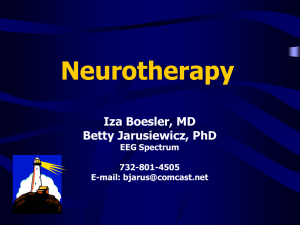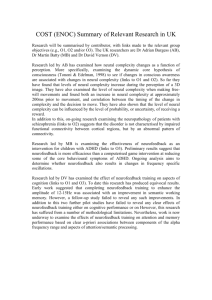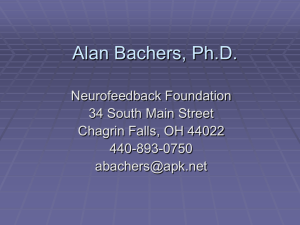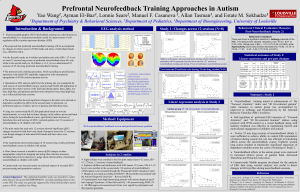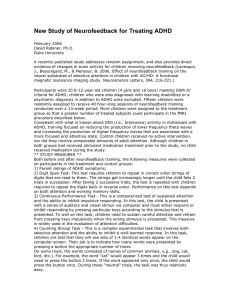Neurofeedback Training for ADHD 1 Evaluation of the Effectiveness of EEG
advertisement
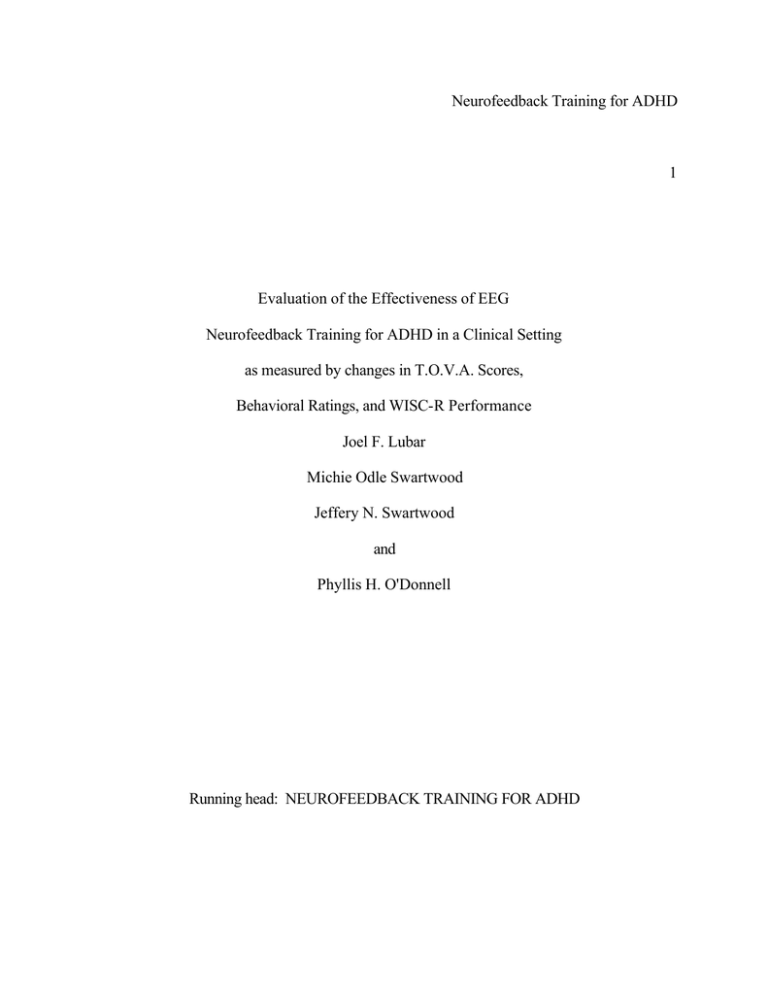
Neurofeedback Training for ADHD 1 Evaluation of the Effectiveness of EEG Neurofeedback Training for ADHD in a Clinical Setting as measured by changes in T.O.V.A. Scores, Behavioral Ratings, and WISC-R Performance Joel F. Lubar Michie Odle Swartwood Jeffery N. Swartwood and Phyllis H. O'Donnell Running head: NEUROFEEDBACK TRAINING FOR ADHD Neurofeedback Training for ADHD 2 Address all correspondence to Joel F. Lubar, Ph.D., University of Tennessee, 310 Austin Peay Building, Knoxville, Tennessee 37996-0900. Abstract Three individual studies were done to assess the effectiveness of neurofeedback treatment for Attention Deficit Hyperactivity Disorder (ADHD). The subject pool for these studies consisted of 23 children and adolescents ranging in age from 8 to 19 years with a mean of 11.4 years who participated in a 2 to 3 month summer program of intensive neurofeedback training. Feedback presentations were contingent on the production of 1620 hz. (beta) activity in the absence of 4-8 hz. (theta) activity. Changes in EEG activity, Test of Variables of Attention (T.O.V.A.) performance, Attention Deficit Disorder Evaluation Scale (ADDES) behavior ratings, and WISC-R performance following neurofeedback training were assessed. Our results were as follows: Study I indicated that subjects who successfully decreased theta activity showed significant improvement in T.O.V.A. performance; Study II revealed significant improvement in parent ratings following neurofeedback training; and Study III indicated significant increases in WISC-R scores following neurofeedback training. These studies are important in that they examine the effects of neurofeedback training on both objective and subjective measures of Neurofeedback Training for ADHD 3 Attention Deficit Disorder under relatively controlled conditions. The results support and extend previous published findings, indicating that neurofeedback training is an appropriate and efficacious adjunctive treatment for ADHD. Neurofeedback Training for ADHD 4 Introduction Attention Deficit/Hyperactivity Disorder (ADHD) is a lifelong pervasive disorder which exists in all countries and cultures. It affects anywhere from 7 to 12 percent of the child population and somewhat less of the adult population depending upon which measures are used in assessing this disorder. At the present time, ADHD is not curable; it is manageable. Treatments involve medications including stimulants, tricyclic antidepressants, and alpha blockers. Nonmedical therapies involve the extensive use of behavior therapy, Cognitive Behavior Therapy, traditional individual psychotherapy, and family systems approaches (Barkley, 1990), (Wolraich et al., 1990). It has now become clear that the primary symptoms of Attention Deficit/Hyperactivity Disorder, inattentiveness, impulsiveness, and hyperactivity, as well as their various manifestations, are really secondary outcomes resulting from an underlying neurological disorder. The basis of this neurological disorder may be decreased arousal and associated with decreased noradrenergic activity (Zametkin et al., 1990), increased slow 4-8 hz. theta activity in frontal and central cortical regions (Mann, Lubar, et al., 1991) and decreased glucose metabolism in both frontal cortical and certain subcortical regions (Zametkin, Nordahl, Gross, 1990). During the past fifteen years, we have been developing a technique, neurofeedback Neurofeedback Training for ADHD 5 training, to help children and adults with ADHD to decrease the excessive slow (theta) activity in their EEG and where appropriate, to increase deficient fast (beta) activity in the EEG. This work has been described previously (Lubar and Deering, 1980; Lubar and Lubar, 1984 and 1991). Replications of this research have been described by Tansey and Bruner, 1983, Tansey, 1990, 1991. Neurofeedback is a form of biofeedback linked to a specific aspect of the electrical activity of the brain such as the frequency, location, amplitude or duration of specific EEG activity. Neurofeedback training is designed to enhance certain types of EEG activity either by itself, or to enhance certain types of EEG activity and decrease other types of EEG activity when it occurs simultaneously, such as the enhancement of beta activity and the inhibition of theta activity in the case of Attention Deficit Disorders or the enhancement of sensorimotor rhythm activity (12-15 hz.) and the suppression of theta activity (4-8 hz.) for helping patients to decrease seizures or hyperactivity (Lubar and Bahler, 1976; Lubar and Shouse, 1977). The purpose of the present study is to evaluate the relationship between several objective and one subjective measure of improvement in a clinically based neurofeedback program over a short time period (2 to 3 months). The variables chosen involve a measure of decreased theta amplitude, a continuous performance test, pre and post changes in Neurofeedback Training for ADHD 6 WISC-R scores, and a subjective measure derived from a behavior rating scale. Study I Effect of Neurofeedback on a Continuous Performance Task Method Subjects. Eighteen subjects participated in this study. All subjects were neurofeedback patients in treatment for Attention Deficit/Hyperactivity Disorder (ADHD). Subjects included three females and fifteen males ranging in age from 8 to 19 years with a mean of 11.4 years. All subjects met the following criteria in order to undergo neurofeedback treatment: 1. Behavior symptomatology consistent with DSM-III-R criteria for the diagnosis of Attention Deficit Disorder; 2. No specific sensory defects or any other comorbid functional or physical illness (e.g., mental retardation, seizure disorders, etc.) that might contribute to or otherwise be confounded with ADHD; 3. Power Spectral Analysis of the EEG displaying a pattern consistent with the diagnosis of ADHD (Mann et al., 1991). All subjects participated in a program during the summer months of 1992 designed to provide intensive neurofeedback training consisting of daily one hour training sessions. Sessions were conducted Monday through Friday for up to eight to ten weeks. Neurofeedback Training for ADHD 7 Neurofeedback training. Assessment was conducted using equipment and software by Lexicor and Stoelting Autogenics Corporations. Neurofeedback treatment was conducted using the Autogenics A620 instrument and software. The Test of Variables of Attention (T.O.V.A.)(Greenberg, 1987) was used to assess changes in performance following neurofeedback training; results were computed by the T.O.V.A. corporation via computer modem. EEG recordings were obtained from bipolar electrodes situated halfway between Cz and Pz and halfway between Fz and Pz; a ground electrode was placed on the earlobe. Subjects' EEGs were sampled at a rate of 128 samples/second. The following physiological responses were monitored during each 50-minute session: (a) theta activity defined as 4-8 hz.; (b) events above threshold level occurring in the absence of 4-8 hz. events; and (c) EMG activity defined as 80-150 hz. activity. Threshold levels were determined for each subject from baseline amplitude measures of theta and beta activity. One of the following treatment paradigms was used: Paradigm 1 - theta thresholds were set at 1 to 2 microvolts ( µv) lower than average µv theta activity; beta thresholds were set at average µv beta activity levels, or Paradigm 2 - theta thresholds were set .5 to 1 microvolt higher than average µv beta activity. Both paradigms were geared toward decreasing theta activity either by directly inhibiting high amplitude Neurofeedback Training for ADHD 8 theta activity, or by rewarding high amplitude beta activity which should entail more concentration and result in decreased theta. Reward criteria were set so that 50 events in .5 seconds were required in order to receive a reward. Events were defined as the production of 16-20 hz. activity above threshold in the absence of 4-8 hz. activity above threshold and/or EMG activity above set threshold level. Each subject's threshold levels were set so that they received between 14 and 25 rewards per minute. Training sessions were subdivided into a 2-minute baseline period, two 5-minute feedback conditions, a 5-minute reading condition with feedback, and a 5-minute listening condition wi th feedback. Continuous Performance Test. As a part of the intake procedure, and again upon completion of treatment, the Test of Variables of Attention (T.O.V.A.) was administered. The T.O.V.A. is a visual continuous performance test in which two easily discriminated visual stimuli are presented for 100 msec every 2 seconds for 22.5 minutes. During administration of the T.O.V.A., subjects were told to watch the screen and click a button whenever a colored square appeared at the top portion of an outer square (target stimulus); if the square appeared at the bottom portion of the outer square (nontarget stimulus), subjects were told to refrain from clicking. Scores derived from the T.O.V.A. were errors of omission, errors of commission, mean correct response time, and Neurofeedback Training for ADHD 9 variability. These variables have been shown to be significantly different between pretreatment and on-medication conditions when evaluating the effects of methylphenidate on performance (Greenberg, 1987). All subjects in this study were free from medication when the T.O.V.A. was administered both before and after training. Results EEG data were analyzed using Pearson Product Moment Correlations. EEG changes were defined as a significant negative correlation of µv theta across sessions (p < .05). Twelve of the subjects showed significant EEG changes in theta across sessions (EEG Change group), while 7 of the subjects did not (No EEG Change group). Beta scores were not used in the establishment of the EEG Change group because of the training paradigm used. Under this paradigm, subjects were taught to decrease microvolts of theta and to increase the percentage of time their beta was above a set threshold. This beta threshold was periodically changed during treatment to maintain the effectiveness of the neurofeedback. However, this variability in the beta threshold makes it inappropriate to examine the percentage of beta scores across sessions. For this reason, only significant decreases in microvolts theta scores, which are not affected by fluctuating threshold levels, were used to define the EEG Change group. Figures 1 and 2 present average decreases in µv Neurofeedback Training for ADHD 10 theta activity for subjects who completed 40 sessions of neurofeedback training. Only subjects who completed 40 sessions were included in the graph to equate the information presented in the two graphs. Nine of the 12 subjects in the EEG Change group and all seven of the subjects in the No EEG Change group completed 40 sessions. A Pearson Product Moment Correlation on sessions by microvolt levels reveals a significant negative correlation (r = -.872, p < .0001) for the data represented in Figure 1. The correlation for the No EEG Change group represented in Figure 2 was not significant. All 18 subjects completed at least 30 sessions. There was a significant negative correlation for those subjects in the EEG change group (r=-.796, p<.05) and no significant correlation for the No EEG Change group over the 30 sessions for which all subjects participated. ---------------------------------------Insert Figures 1 and 2 about here ---------------------------------------Additionally, no significant differences were found between subjects trained under paradigm 1 and those trained under paradigm 2. Figure 3 is an illustrative example of the decrease in peak-peak microvolts ( µv) of theta over 34 sessions for an adolescent age 14. The data is automatically stored and graphed by the neurofeedback software of the A620 for five conditions. These include a baseline (COND 01), two feedback only conditions Neurofeedback Training for ADHD 11 (COND 02, 04), feedback while reading (03), and feedback while listening (05). This individual was in the group that showed a significant negative correlation in µv of theta over sessions. --------------------------------------Insert Figure 3 about here --------------------------------------T.O.V.A. changes were assessed by determining the number of T.O.V.A. scales, out of four possible, in which improvement occurred for each child. Independent t-tests were used to assess significant effects of EEG change on T.O.V.A. performance. Figure 4 shows that successful neurofeedback training resulted in improved T.O.V.A. performance. The group of children who showed significant EEG changes (N = 12) improved on an average of three T.O.V.A. scales, while the group with no EEG changes (N = 7) improved on an average of 1.5 T.O.V.A. scales (t = 2.99, P < .01, two -tail). ---------------------------------------Insert Figure 4 about here ---------------------------------------Discussion This study provides an objective assessment of the efficacy of neurofeedback Neurofeedback Training for ADHD 12 treatment for ADHD. Improved performance on continuous performance tests such as the T.O.V.A. following pharmacological intervention has been well documented (Greenberg, 1987). The finding of significant changes in T.O.V.A. performance following successful neurofeedback training provides evidence that decreasing slow EEG activity also leads to more normal performance on a task which is sensitive to the effects of pharmacological intervention for ADHD. However, while pharmacological treatments for ADHD such as methylphenidate significantly improve T.O.V.A. performance, the effects are transitory and only present while blood levels of the medication are at a therapeutic level. The effects of neurofeedback appear to provide a change in performance without continual external intervention (e.g., subjects received no neurofeedback during administrations of the T.O.V.A.). Study II Effect of Neurofeedback on Behavior Ratings Method Subjects. Subjects included in this study were two females and eleven males. Criteria for participation in this study were identical to criteria in Study I. Neurofeedback Training. Assessment was conducted using equipment and software Neurofeedback Training for ADHD 13 by both Lexicor and Autogenics Corporations. Neurofeedback treatment was conducted using the Autogenics A620 instrument and software. The training paradigms used with these subjects were the same as those in Study I. Behavioral Measures. In order to assess behavioral changes as rated by parents, the McCarney Attention Deficit Disorders Evaluation Scale (ADDES) was completed by parents pre- and post-neurofeedback training. The ADDES was designed in order to provide a measure of the three characteristics of the DSM-III-R definition of Attention Deficit Disorder; the subscales measured by the ADDES were inattention, impulsivity, and hyperactivity. Forty-six items are included on the scale, and parents were instructed to rate the child's behavior in the home environment on a scale of 0 to 4 (0 = does not engage in the behavior, 4 = one to several times per hour). Raw scores on each of the subscales were converted into standard scores. Results Differences in ADDES standard scores before and after treatment were assessed using Pearson Correlations. Behavioral reports by parents on the ADDES indicate significant behavioral improvement following neurofeedback training in each of the three subscales: hyperactivity (t = -4.60, p < .0001), impulsivity (t = - 6.596, p < .001), and Neurofeedback Training for ADHD 14 inattention (t = -4.474, p < .001). Figure 5 presents standard scores for each ADDES scale pre- and post-treatment. ---------------------------------------Insert Figure 5 about here ---------------------------------------A subset of the above subjects (n = 11) who were trained under identical conditions were reanalyzed according to whether or not they made significant EEG changes in the expected directions. The criteria for these two groups were the same as in Study I. The results showed no significant differences in behavior ratings between those subjects who made EEG changes in the expected directions and those who did not. Discussion Results of this study point out one of the major problems encountered in using subjective behavior rating scales. Parents often tend to overemphasize positive gains that are made as the result of a treatment intervention. Based on the measurement of decreased amplitude of theta activity over sessions, there were no significant differences between the group that showed EEG changes and those that did not show EEG changes. Both groups showed improvement. This may or not be possibly interpreted as a placebo or non-specific effect of an intervention. Neurofeedback Training for ADHD 15 We suggest that a long term followup study of the patients over a period of several years who did and did not show EEG changes might reveal differences between the EEG Change and No EEG Change group. Another possibility is that some other measure of EEG change may have differentiated better between those individuals showing the greatest behavioral rating scale changes and those showing the least. These measures include the percent of theta activity over sessions, microvolts or percent of beta activity over sessions, or microvolt levels of beta or perhaps even the ratio of theta to beta activity over sessions. It was impossible, however, to evaluate these other measures in this study because of changes of thresholds as mentioned earlier. However, as far as theta microvolt levels are concerned, these did not differentiate between subjects who improved and those who did not improve in behavior rating scales. Study III Effect of Neurofeedback on IQ scores Method Subjects. Nine males and one female were included in this study. Criteria for participation in this study were identical to criteria in Studies I and II. Neurofeedback Training. Assessment and treatment were conducted using equipment and software by both Lexicor and Autogenics Corporations. The Lexicor NRS- Neurofeedback Training for ADHD 16 24 Biolex program was used with six of the subjects; Autogenics A620 software was used with 4 of the subjects. Treatment protocols, while necessarily different according to individual software requirements, were geared toward the inhibition of theta activity and rewarding of beta activity. Band passes for reward and inhibit frequencies were the same as those used in Studies I and II. An additional EMG electrode placed mid-forehead was used with the Lexicor neurofeedback software. Training sessions were subdivided in the same manner as described in Studies I and II. Intelligence testing. Subjects in this study were administered the Wechsler Intelligence Scale for Children-Revised (WISC-R) approximately two years prior to the beginning of neurofeedback treatment. Upon completion of neurofeedback treatment, subjects were reassessed using the WISC-R. Results All subjects included in this study made significant EEG changes. Significant differences were found between pre-and post-treatment IQ scores: verbal (t = -3.65, p < .005), performance (t = -2.18, p < .05), full scale (t = -3.68, p < .005). Figure 6 represents mean IQ scores pre- and post-treatment. Neurofeedback Training for ADHD 17 ---------------------------------------Insert Figure 6 about here ---------------------------------------Discussion This study supports the effectiveness of neurofeedback training; since all subjects in this study showed significant decrease in the microvolt levels of theta and improvement in pre and post IQ scores. Test-retest validity is not a problem since the period of time between testing and retesting was approximately two years and in some cases, longer. General Discussion The significance of the present study is that it examines the interrelationships between several variables, some of which are objective measures of performance improvement. These are the T.O.V.A., changes in EEG activity, and changes in WISC-R scores associated with neurofeedback training. The subjective measure, the Behavior Rating Scale, did not differentiate between the groups of children that showed EEG changes and those that did not. One of the advantages of the present study is that the training conditions, although carried out in a clinical fee-for-service setting, were done under relatively controlled conditions. The participants were seen intensively over a short period of time. They engaged in neurofeedback training in which as few changes as possible were Neurofeedback Training for ADHD 18 made in threshold settings in order to insure good learning. Other treatment interve ntions such as individual psychotherapy, behavior modification programs, and medication were held as constant as possible. This is much easier to accomplish in a short term study of this kind than in the types of studies that had been described previously by Lubar and Lubar (1984), Lubar (1991), Tansey (1990, 1991). Patients described in those studies were seen over much longer time periods and received fewer sessions per week, usually two or less. Because the length of treatment sometimes ranged from four months to a year or longer, other treatment interventions made it more difficult to determine the effectiveness of the neurofeedback as a primary component. The number of sessions, however, in those studies and in the present one were very comparable. Typically, neurofeedback training involves between 40 and 60 sessions. Another conclusion from our present research is that for children, particularly below the age of 14, reduction of µv theta activity appears to be the main measure associated with improvement in ADHD manifestations. In contrast, we are finding that for adults, increasing the amplitude and duration of beta activity may be more important than decreasing the amplitude and duration of theta activity. In children, especially since there is often a maturational lag reflected in the persistence of slower activity in EEG as compared with age dependent norms (Mann, Lubar, et al., 1991), the amplitude of beta activity may be Neurofeedback Training for ADHD 19 adequate in children with ADHD, but often is overshadowed by the excessive theta activity. In adults, theta activity may be well within the normal range in terms of amplitude, however, the beta activity may be significantly decreased. In order to better understand the relative contribution of variables that are associated with improvement as a result of intervention with children with ADHD, a matched groups research design probably offers the best approach. In such a design, there would be a control group which receives pre and post measurements without any intervention, a neurofeedback group which receives only neurofeedback, all other interventions being held constant, a group administered only behavior therapy with no other intervention, or some other type of intervention, and even a group which is administered only stimulant medications with no other intervention. Based on our clinical experience, it is clear that EEG neurofeedback training for Attention Deficit/Hyperactivity Disorder is a powerful adjunctive technique which is part of a multicomponent treatment process. Its effects therefore are additive and are strongest when combined clinically with other treatment modalities. An outcome study involving different interventions and matched controls however cannot be carried out in a fee-for-service setting and is a more appropriate model for laboratory conditions. Neurofeedback Training for ADHD 20 Neurofeedback Training for ADHD 21 References Barkley, R. A. (1990). Attention Deficit Hyperactivity Disorder: A handbook for diagnosis and treatment. New York: Guilford Press. Brown, R. T., Borden, K. A., Wynne, M. E., Schleser, R., et al. (1986). Methylphenidate and cognitive therapy with ADD children: A methodological reconsideration. Journal of Abnormal Child Psychology, 14(4), 481-497. Greenberg, L. (1987). An objective measure of methylphenidate response: Clinical use of the MCA. Psychopharmacology Bulletin, 23, 279-282. Lubar, J. F. (1991). Discourse on the development of EEG diagnostics and biofeedback treatment for attention-deficit/hyperactivity disorders. Biofeedback and Self-Regulation, 16, 201-225. Lubar, J. F., & Bahler, W. W. (1976). Behavioral management of epileptic seizures following EEG biofeedback training of the sensorimotor rhythm. Biofeedback and Self-Regulation, 7, 77-104. Lubar, J. F., & Deering, W. M. (1981). Behavioral approaches to neurology. New York: Academic Press. Lubar, J. F., & Lubar, J. (1984). Electroencephalographic biofeedback of SMR and beta for treatment of attention deficit disorders in a clinical setting. Biofeedback and Self- Neurofeedback Training for ADHD 22 Regulation, 9, 1-23. Lubar, J. F., & Shouse, M. N. (1977). Use of biofeedback in the treatment of seizure disorders and hyperactivity. In B. B. Lahey & A. E. Kazdin (Eds.), Advances in Clinical Child Psychology (pp. 203-265). New York: Plenum Press. Mann, C. A., Lubar, J. F., Zimmerman, A. W., Miller, C. A., & Muenchen, R. A. (1990). Quantitative analysis of EEG in boys with attentiondisorder (ADHD): A controlled study with clinical deficit/hyperactivity implications. Pediatric Neurology (in press). Mann, C., Lubar, J., Zimmerman, A., Miller, C., & Muenchen, R. (1991). analysis of EEG in boys with attention-deficit-hyperactivity with clinical implications. Pediatric Neurology, 8, Quantitative disorder: Controlled study 30-36. Sterman, M. G., Macdonald, L. R., & Stone, R. K. (1974). Biofeedback training of sensorimotor electroencephalographic rhythm in man: Effects on epilepsy. Epilepsia, 15, 395-416. Tansey, M. A. (1990). Righting the rhythms of reason, EEG biofeedback training as a therapeutic modality in a clinical office setting. Medical Psychotherapy, 3, 57-68. Tansey, M. A. (1991). Wechsler's (WISC-R) changes following treatment of the Neurofeedback Training for ADHD 23 learning disabilities via EEG biofeedback training in a private setting. Australian Journal of Psychology, 43, 147-153. Tansey, M. A., & Bruner, R. L. (1983). EMG and EEG biofeedback training in the treatment of a 10-year-old hyperactive boy with a developmental reading disorder. Biofeedback and Self-Regulation, 8, 25-37. Wolraich, M. L., Lindgren, S., Stromquist, A., Milich, R., Davis, C., & Watson, D. (1990). Stimulant medication use by primary care physicians in the treatment of attention-deficit hyperactivity disorder. Pediatrics, 86, 95-101. Zametkin, A. J., Nordahl, T. E., Gross, M., et al. (1990). Cerebral glucose metabolism in adults with hyperactivity of childhood onset. New England Journal of Medicine, 323, 1361-1366. Neurofeedback Training for ADHD 24 Figure Captions Figure 1 Decrease in µv theta for the EEG change group for those subjects completing 40 sessions. Figure 2 Decrease in µv theta for the no EEG change group for those subjects completing 40 sessions. Figure 3 Illustrative example of decrease in µv theta over sessions for 14 year old male in the EEG change group. Figure 4 Comparison of number of T.O.V.A. scales in which improve ment occurred in the EEG change and no EEG change groups. Figure 5 Standard scores for each ADDES scale pre- and post-treatment for 13 subjects. Figure 6 WISC-R scores pre- and post-treatment for 13 subjects.

